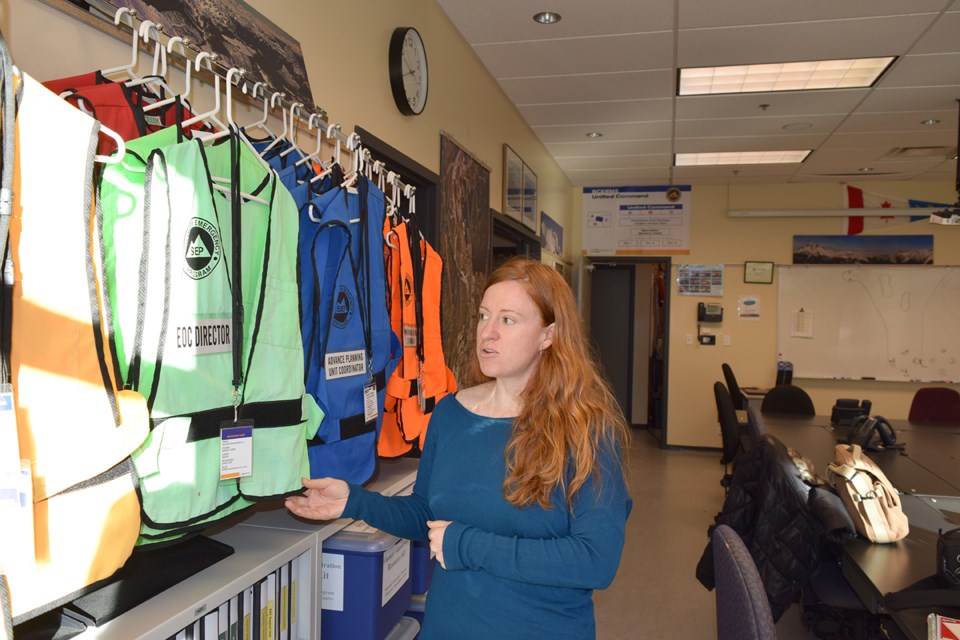Want to find out what it would feel like to live through an 8.0-magnitude earthquake? The Quake Cottage is coming to Squamish’s Brennan Park this spring.
“It is a simulation,” said Alexis Kraig, district emergency coordinator.
People can go into the cottage, which is set up like an average living room but with shelves and seats bolted down, and when the simulator is turned on, it becomes evident how much people and things move around during a significant quake.
The idea is help people find out what it is like to experience a quake so they will be motivated to prepare, Kraig said. The event will also include information on preparing for earthquakes or other disasters, and emergency kits will be available for sale.
Council adopted the All Hazards Plan, which includes earthquake response, at council on March 8.
Squamish has recent experience with emergencies, which could serve the community well when an earthquake hits, Kraig noted in an interview at Squamish Emergency Program headquarters on Finch Drive.
The Squamish Terminals fire in April of 2015, the Stawamus Chief rockslide a week later as well as the wildfires in August meant the district emergency operations centre was used, and residents got used to thinking about the possibility of things going wrong, she said. “We are a little bit more resilient because we have had disasters, and that has prompted people to become more prepared,” said Kraig.
In 2015, the district logged 750 fire, 4,000 ambulance, 92 Search and Rescue and 23 Marine Search and Rescue responses.
The community also has the advantage of trained volunteers ready to mobilize. Squamish has 62 volunteer Squamish Search and Rescue members, 50 volunteer firefighters, 18 Red Cross volunteers, 22 Marine Search and Rescue members and 12 Emergency Radio Communications volunteers, according to the district.
Squamish also has relatively newer building stock compared to other communities such as Victoria, which has aging downtown buildings, Kraig said.
“Although we are susceptible to an earthquake, it is not like what would happen in Victoria or Vancouver,” she said. “The City of Victoria, their downtown will crumble… and all their first responder structures are going to collapse.”
About $2 million worth of seismic upgrades are currently underway at Squamish fire halls, according to Kraig.
Earthquakes are relatively common occurrences on the B.C. coast – a 5.2 magnitude earthquake off the west coast of Vancouver Island hit March 18.
“It is the movement of tectonic plates that causes earthquakes, causes volcanoes,” said John Cassidy, earthquake seismologist with Natural Resources Canada. “The plates in our region are moving at about five centimetres per year, which is roughly how fast your fingernails grow.”
The oceanic Juan de Fuca Plate is moving towards Vancouver Island and Washington State.
Over 100 years, the plates should move about five metres along the plate boundaries, Cassidy said. However, the tectonic plates are generally stuck together – a “locked fault” storing energy for a future earthquakes – which is when the plates will slip. Deep earthquakes are the most frequent type of damaging earthquake from southern B.C. to northern California, he said.
Fifteen years ago, the Nisqually earthquake, centred near Olympia about 150 kilometres southeast of Victoria, was felt all across southern B.C.
In Washington State, closer to the quake’s epicentre, hundreds of people were injured and about $2 billion worth of damage was reported.
Earthquakes can occur anywhere from on the surface to 30 kilometres within the crust of the North American Plate upon which Squamish and Vancouver Island sits, Cassidy added. A magnitude 7.3 occurred on this plate in 1946, a magnitude 7 in 1918 and a 6.8 hit in 1872.
Cassidy said while much is known about how earthquakes work and the damage they can do, what is not yet known is how to predict when they may hit.
“They strike without warning,” Cassidy said. “Our research into earthquakes allows us to estimate the ground shaking that we can expect during future earthquakes – and this information feeds directly into Canadian building, bridge and dam codes.”
But the best that we can do as individuals is be prepared, he said.
The Quake Cottage will be at Brennan Park Committee Recreation Centre on May 12, from 10 a.m. to 6 p.m. The Cottage, which costs $10,000 per day, will be funded by a grant from FortisBC and the Insurance Bureau of Canada, according to Kraig.



